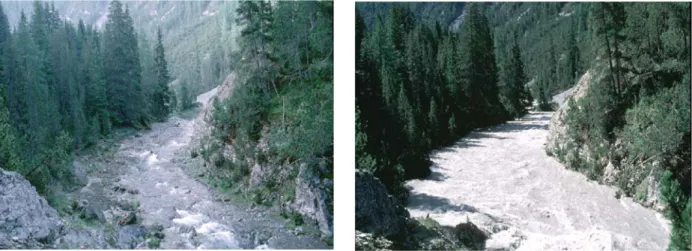Feature Article
Using artificial floods for restoring river integrity
Christopher T. Robinson and Urs UehlingerDepartment of Limnology, EAWAG/ETHZ, Überlandstrasse 133, CH-8600 Dübendorf, Switzerland
There is growing recognition by resource managers on the importance of the natural flow regime in maintaining river integrity downstream of large dams. Historically, ar-tificial floods from reservoirs were regarded simply as flushing flows for removing fine sediments in down-stream receiving waters or for reservoir maintenance (Reiser et al., 1985). These flushing flows tended to be a-periodic and infrequent, being implemented during the most economically feasible time of the year and usually over multi-annual periods (e. g., 5 – 7 year intervals). In-deed, the use of artificial floods to meet ecological needs in concert with economic and societal needs is a rather re-cent development, and is in line with current adaptive management principles. The use of artificial floods for restoring some semblance of the natural flow regime in regulated rivers is quite complex, involving multiple in-terest groups and being system specific. As a
conse-Aquat. Sci. 65 (2003) 181– 182 1015-1621/03/030181-02 DOI 10.1007/s00027-003-0002-0 © EAWAG, Dübendorf, 2003
Aquatic Sciences
quence, relatively few examples of integrating artificial floods in flow management schemes are noted in the lit-erature (e. g., Molles et al., 1998). For instance, even the widely publicized Glen Canyon experimental release oc-curred once, although plans are now being considered for additional floods in this system (Powell, 2002).
The Spöl River flows from Livigno Reservoir on the Italian/Swiss border through the Swiss National Park. Through various negotiations, the different interest groups agreed to implement a flood release program to improve ecological conditions in the river downstream of the reservoir (Fig. 1). The situation was such that the im-plementation was considered a classical win-win situa-tion, and indeed, the concessions of flow management from the reservoir have been changed because of the pos-itive results of the initial floods. The program consisted of employing multiple intra-annual floods each year. The
*Corresponding author phone: + 41 1 823 5317; fax: + 41 1 823 5315; e-mail: robinson@eawag.ch Published on Web: September 23, 2003
Figure 1. Photograph of the River Spöl at one of the study reaches (Punt Periv) under residual conditions (1.6 m3/s) and during the
current agenda is to incorporate two artificial floods of sufficient magnitude each year, with flood magnitude de-termined through annual monitoring of ecological condi-tions in the river. For example, the magnitude of later floods was increased from that of the initial floods be-cause of sequential changes in sediment composition fol-lowing each flood (see papers in this feature). The results clearly emphasize the importance of monitoring for a flood program to be adaptive and successful.
This special feature represents various facets of the flood program on the River Spöl over a four year study period. Scheurer and Molinari (2003) describe the histor-ical, engineering, and management decisions resulting in the flood program. The papers following present the mon-itoring results from the different research groups involved in documenting ecological responses of the river to the floods. Specifically, Mürle et al. (2003) report on mor-phological changes in river structure and riparian vegeta-tion, Uehlinger et al. (2003) document changes in pri-mary producers and system metabolism. Robinson et al. (2003) and Jakob et al. (2003) show responses by the macroinvertebrate assemblages to the floods, and Ortlepp and Mürle (2003) report on the changes in the fishery. We hope the publication of our findings will inspire resource managers of other reservoir/river systems to implement similar flow programs for improving the ecological state of regulated rivers.
The research was made possible through a general agreement between the Swiss National Park, Power Plant Officials, and State and Federal Authorities. Much sup-port and encouragement was provided by Thomas
Scheurer of the Research Council of the Swiss National Park and Peter Molinari of the Engadin Hydroelectric Power Company. Partial funding was provided by the Re-search Council of the Swiss National Park and the Swiss Federal Institute for Environmental Science and Technol-ogy (EAWAG). We wish to thank all the research groups for a productive and enthusiastic atmosphere for con-ducting this research.
References
Jakob, C., C. T. Robinson and U. Uehlinger, 2003. Longitudinal ef-fects of experimental floods on stream benthos downstream of a large dam. Aquat. Sci. 65(3): 223–231.
Molles, M. C., C. S. Crawford, L. M. Ellis, H. M. Valett and C. N. Dahm, 1998. Managed flodding for riparian ecosystem restora-tion. BioScience 48: 749–756.
Mürle, U., J. Ortlepp and M. Zahner, 2003. Effects of experimental flooding on riverine morphology, structure and riparian vegeta-tion: The River Spöl, Swiss National Park. Aquat. Sci. 65(3): 191–198.
Powell, P., 2002. Open the floodgates! Nature 420: 356–358. Reiser, D. W., M. P. Ramey and T. R. Lampert, 1985. Review of
flushing flow requirements in regulated streams. Bechtel Group, San Francisco, CA, USA.
Robinson, C. T., U. Uehlinger and M. T. Monaghan, 2003. Effects of a multi-year experimental flood regime on macroinverte-brates downstream of a reservoir. Aquat. Sci. 65(3): 210–222. Scheurer, T. and P. Molinari, 2003. Experimental floods in the River
Spöl, Swiss National Park: framework, objectives and design. Aquat. Sci. 65(3): 183–190.
Uehlinger, U., B. Kawecka and C. T. Robinson, 2003. Effects of ex-perimental floods on periphyton and stream metabolism below a high dam in the Swiss Alps (River Spöl). Aquat. Sci. 65(3): 199–209.
